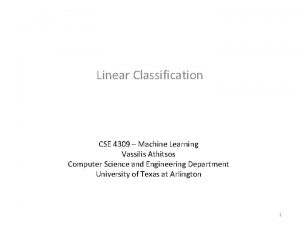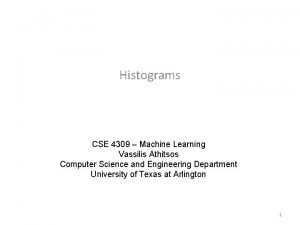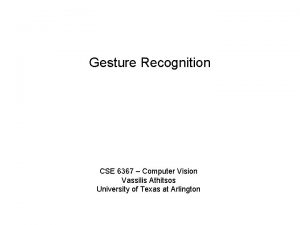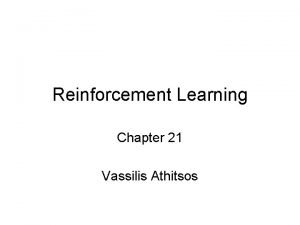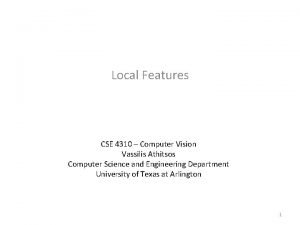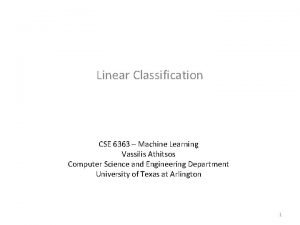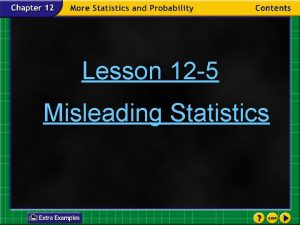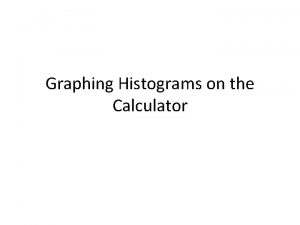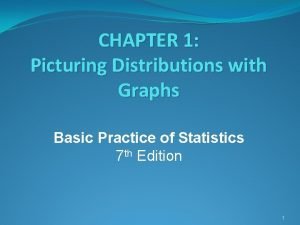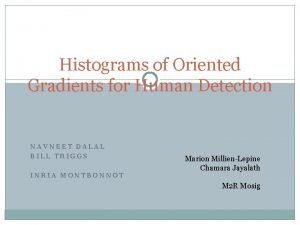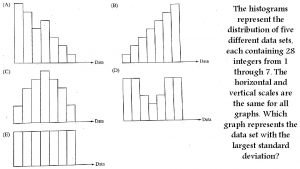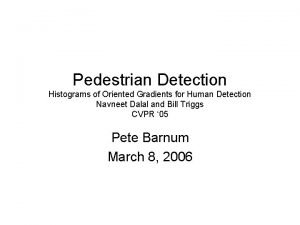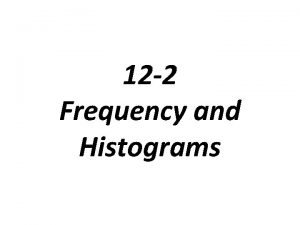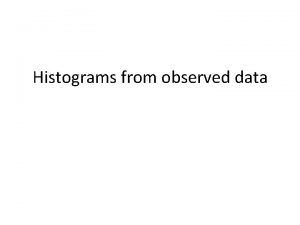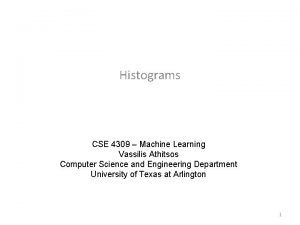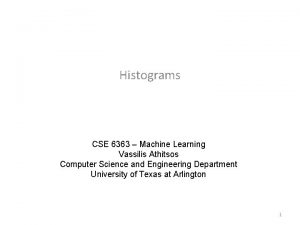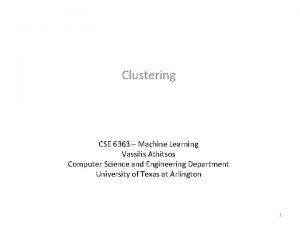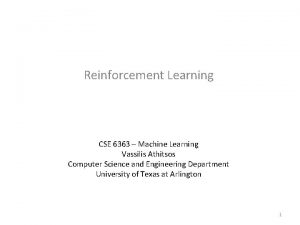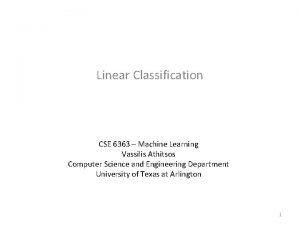Histograms CSE 4309 Machine Learning Vassilis Athitsos Computer




































- Slides: 36

Histograms CSE 4309 – Machine Learning Vassilis Athitsos Computer Science and Engineering Department University of Texas at Arlington 1

Example Application: Skin Detection Input Image • Goal: find skin pixels in the image. • In the output: – White pixels are pixels classified as “skin”. – Black pixels are pixels classified as “not skin”. Example Output Image • This is an opportunity to talk about images. • We will use images as data in several cases this semester. 2

Pixel-Based Skin Detection Input Image • In pixel-based skin detection, each pixel is classified as skin or nonskin, based on its color. • No other information is used. – Each pixel is classified independently of any other pixel. Output Image • So, the input space is the space of 3 D vectors (r, g, b), such that r, g, b are integers between 0 and 255. • The output space is binary ("skin" or "non skin"). 3

Example Application: Skin Detection • Why would skin detection be useful? 4

Example Application: Skin Detection • Why would skin detection be useful? – It is very useful for detecting hands and faces. – It is used a lot in computer vision systems for person detection, gesture recognition, and human motion analysis. 5

Examples of Skin Detection Input Image Output Image • The classifier is applied individually on each pixel of the input image. • In the output: – White pixels are pixels classified as “skin”. – Black pixels are pixels classified as “not skin”. 6

Examples of Skin Detection Input Image Output Image • The classifier is applied individually on each pixel of the input image. • In the output: – White pixels are pixels classified as “skin”. – Black pixels are pixels classified as “not skin”. 7

Building a Skin Detector • We want to classify each pixel of an image, as skin or non-skin. • What is the input to the classifier? 8

Building a Skin Detector • We want to classify each pixel of an image, as skin or non-skin. • What is the input to the classifier? • Three integers: R, G, B. Each is between 0 and 255. – The red, green, and blue values of the color of the pixel. • If we want to use a Bayes classifier, which probability distributions do we need to estimate? 9

Estimating Probabilities • If we want to use a pseudo-Bayes classifier, which probability distributions do we need to estimate? – p(skin | R, G, B) – p(not skin | R, G, B) • To compute the above probability distributions , we first need to compute: – – p(R, G, B | skin) p(R, G, B | not skin) p(not skin) 10

Estimating Probabilities • We need to compute: – – p(R, G, B | skin) p(R, G, B | not skin) p(not skin) • To compute these quantities, we need training data. – We need lots of pixels, for which we know both the color and whether they were skin or non-skin. • p(skin) is a single number. – How can we compute it? 11

Estimating Probabilities • We need to compute: – – p(R, G, B | skin) p(R, G, B | not skin) p(not skin) • To compute these quantities, we need training data. – We need lots of pixels, for which we know both the color and whether they were skin or non-skin. • p(skin) is a single number. – We can simply set it equal to the percentage of skin pixels in our training data. • p(not skin) is just 1 - p(skin). 12

Estimating Probabilities • How about p(R, G, B | skin) and p(R, G, B | not skin)? – How many numbers do we need to compute for them? 13

Estimating Probabilities • How about p(R, G, B | skin) and p(R, G, B | not skin)? – How many numbers do we need to compute for them? • How many possible combinations of values do we have for R, G, B? 14

Estimating Probabilities • How about p(R, G, B | skin) and p(R, G, B | not skin)? – How many numbers do we need to compute for them? • How many possible combinations of values do we have for R, G, B? – 2563 = 16, 777, 216 combinations. • So, we need to estimate about 17 million probability values for p(R, G, B | skin) • Plus, we need an additional 17 million values for p(R, G, B | not skin) 15

Estimating Probabilities • So, in total we need to estimate about 34 million numbers. • How do we estimate each of them? • For example, how do we estimate p(152, 24, 210 | skin)? 16

Estimating Probabilities • So, in total we need to estimate about 34 million numbers. • How do we estimate each of them? • For example, how do we estimate p(152, 24, 210 | skin)? • We need to go through our training data. – Count the number of all skin pixels whose color is (152, 24, 210). • Divide that number by the total number of skin pixels in our training data. • The result is p(152, 24, 210 | skin). 17

Estimating Probabilities • How much training data do we need? 18

Estimating Probabilities • How much training data do we need? • Lots, in order to have an accurate estimate for each color value. • Even though estimating 34 million values is not an utterly hopeless task, it still requires a lot of effort in collecting data. • Someone would need to label billions of pixels as skin or non skin. • While doable (at least by a big company), it would be a very time-consuming and expensive undertaking. 19

Histograms • Our problem is caused by the fact that we have to many possible RGB values. • Do we need to handle that many values? 20

Histograms • Our problem is caused by the fact that we have to many possible RGB values. • Do we need to handle that many values? – Is p(152, 24, 210 | skin) going to be drastically different than p(153, 24, 210 | skin)? – The difference in the two colors is barely noticeable to a human. Color: (152, 24, 210) Color: (153, 24, 210) • We can group similar colors together. • A histogram is an array (one-dimensional or multidimensional), where, at each position, we store the frequency of occurrence of a certain range of values. 21

Histograms • For example, if we computed p(R, G, B | skin) for every combination, the result would be a histogram. – More specifically, it would be a three-dimensional 256 x 256 histogram (a 3 D array of size 256 x 256). – Histogram[R][G][B] = frequency of occurrence of that color in skin pixels. • However, a histogram allows us to group similar values together. • For example, we can represent the p(R, G, B | skin) distribution as a 32 x 32 histogram. – To find the histogram position corresponding to an R, G, B combination, just divide R, G, B by 8, and take the floor. 22

Histograms • Suppose that we represent p(R, G, B | skin) as a 32 x 32 histogram. – Thus, the histogram is a 3 D array of size 32 x 32. – To find the histogram position corresponding to an R, G, B combination, just divide R, G, B by 8, and take the floor. • Then, what histogram position corresponds to RGB value (152, 24, 210)? 23

Histograms • Suppose that we represent p(R, G, B | skin) as a 32 x 32 histogram. – Thus, the histogram is a 3 D array of size 32 x 32. – To find the histogram position corresponding to an R, G, B combination, just divide R, G, B by 8, and take the floor. • Then, what histogram position corresponds to RGB value (152, 24, 210)? • floor(152/8, 24/8, 210/8) = (19, 3, 26). • So, to look up the histogram value for RGB color (152, 24, 210), we look at position [19][3][26] of the histogram 3 D array. • In this case, each position in the histogram corresponds to 8 x 8 x 8 = 512 distinct RGB combinations. • Each position in the histogram is called a bin, because it counts 24 the frequency of multiple values.

How Many Bins? • How do we decide the size of the histogram? – Why 32 x 32? – Why not 16 x 16, or 8 x 8 x 8, or 64 x 64? 25

How Many Bins? • How do we decide the size of the histogram? – Why 32 x 32? – Why not 16 x 16, or 8 x 8 x 8, or 64 x 64? • Overall, we have a tradeoff: – Larger histograms require more training data. – If we do have sufficient training data, larger histograms give us more information compared to smaller histograms. – If we have insufficient training data, then larger histograms give us less reliable information than smaller histograms. • How can we choose the size of a histogram in practice? 26

How Many Bins? • How do we decide the size of the histogram? – Why 32 x 32? – Why not 16 x 16, or 8 x 8 x 8, or 64 x 64? • Overall, we have a tradeoff: – Larger histograms require more training data. – If we do have sufficient training data, larger histograms give us more information compared to smaller histograms. – If we have insufficient training data, then larger histograms give us less reliable information than smaller histograms. • How can we choose the size of a histogram in practice? – Just try different sizes, see which one is the most accurate. 27

The Statlog Dataset • Another dataset that we will use several times in this course, is the UCI Statlog dataset (we also call it the Satellite dataset). • Input: a 36 -dimensional vector, describing a pixel in an image taken by a satellite. – The value in each dimension is an integer between 1 and 157. • Why 36 dimensions? – To describe each pixel, four basic colors are used, instead of the standard three colors (r, g, b) we are used to. – To classify a pixel, information is used from its 8 neighboring pixels. So, overall, 9 pixels x 4 colors = 36 values. • Output: type of soil shown on the picture. 1: red soil 2: cotton crop 3: grey soil 4: damp grey soil 5: soil with vegetation stubble 7: very damp grey soil 28

Limitations of Histograms • For skin detection, histograms are a reasonable choice. • How about the satellite image dataset? – There, each pattern has 36 dimensions (i. e. , 36 attributes). • What histogram size would make sense here? 29

Limitations of Histograms • For skin detection, histograms are a reasonable choice. • How about the satellite image dataset? – There, each pattern has 36 dimensions (i. e. , 36 attributes). • What histogram size would make sense here? • Even if we discretize each attribute to just two values, we still need to compute 236 values, which is about 69 billion values. • We have 4, 435 training examples, so clearly we do not have enough data to estimate that many values. 30

Naïve Bayes with Histograms • The naive Bayes classifier assumes that the different dimensions of an input vector are independent of each other given the class. • Using the naïve Bayes approach, what histograms do we compute for the satellite image data? 31

Naïve Bayes with Histograms • The naive Bayes classifier assumes that the different dimensions of an input vector are independent of each other given the class. • Using the naïve Bayes approach, what histograms do we compute for the satellite image data? – Instead of needing to compute a 36 -dimensional histogram, we can compute 36 one-dimensional histograms. • Why? 32

Naïve Bayes with Histograms • The naive Bayes classifier assumes that the different dimensions of an input vector are independent of each other given the class. • Using the naïve Bayes approach, what histograms do we compute for the satellite image data? – Instead of needing to compute a 36 -dimensional histogram, we can compute 36 one-dimensional histograms. • Why? Because of independence. We can compute the probability distribution separately for each dimension. – p(X 1, X 2, …, X 36 | Ck) = ? ? ? 33

Naïve Bayes with Histograms • The naive Bayes classifier assumes that the different dimensions of an input vector are independent of each other given the class. • Using the naïve Bayes approach, what histograms do we compute for the satellite image data? – Instead of needing to compute a 36 -dimensional histogram, we can compute 36 one-dimensional histograms. • Why? Because of independence. We can compute the probability distribution separately for each dimension. – p(X 1, X 2, …, X 36 | Ck) = p 1(X 1 | Ck) * p 2(X 2| Ck) * … * p 36(X 36 | Ck) 34

Naïve Bayes with Histograms • Suppose that build these 36 one-dimensional histograms. • Suppose that we treat each value (from 1 to 157) separately, so each histogram has 157 bins. • How many numbers do we need to compute in order to compute our p(X 1, X 2, …, X 36 | Ck) distribution? 35

Naïve Bayes with Histograms • Suppose that build these 36 one-dimensional histograms. • Suppose that we treat each value (from 1 to 157) separately, so each histogram has 157 bins. • How many numbers do we need to compute in order to compute our p(X 1, X 2, …, X 36 | Ck) distribution? • We need 36 histograms (one for each dimension). – 36*157 = 5, 652 values. – Much better than 69 billion values for 236 bins. • We compute p(X 1, X 2, …, X 36 | Ck) for six different classes c, so overall we compute 36*157*6 = 33, 912 values. 36
 Vassilis athitsos
Vassilis athitsos Athitsos
Athitsos Vassilis athitsos
Vassilis athitsos Vassilis athitsos
Vassilis athitsos Vassilis athitsos
Vassilis athitsos Vassilis athitsos
Vassilis athitsos Vassilis athitsos
Vassilis athitsos Fisher's
Fisher's Awareio
Awareio Concept learning task in machine learning
Concept learning task in machine learning Analytical learning in machine learning
Analytical learning in machine learning Pac learning model in machine learning
Pac learning model in machine learning Machine learning t mitchell
Machine learning t mitchell Inductive and analytical learning
Inductive and analytical learning Analytical learning vs inductive learning
Analytical learning vs inductive learning Instance based learning in machine learning
Instance based learning in machine learning Inductive learning machine learning
Inductive learning machine learning First order rule learning in machine learning
First order rule learning in machine learning Eager learning algorithm
Eager learning algorithm Deep learning vs machine learning
Deep learning vs machine learning Frequency tables and line plots
Frequency tables and line plots Misleading statistics examples
Misleading statistics examples Print on short edge meaning
Print on short edge meaning Histogram of unequal class interval
Histogram of unequal class interval Histogram graphing calculator
Histogram graphing calculator 9-3 histograms and box plots
9-3 histograms and box plots Dr frost maths cumulative frequency
Dr frost maths cumulative frequency One advantage of stemplots over histograms is that
One advantage of stemplots over histograms is that Histograms of oriented gradients for human detection
Histograms of oriented gradients for human detection The histograms below represent the distribution of five
The histograms below represent the distribution of five Histograms of oriented gradients for human detection
Histograms of oriented gradients for human detection Uniform symmetric or skewed
Uniform symmetric or skewed Histogram algebra 1
Histogram algebra 1 Histograms
Histograms How to calculate frequency density
How to calculate frequency density Cuadro comparativo de e-learning b-learning y m-learning
Cuadro comparativo de e-learning b-learning y m-learning Finite state machine vending machine example
Finite state machine vending machine example
